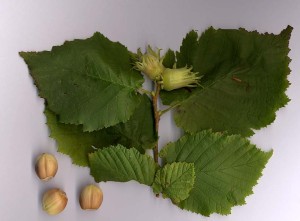Corylus avellana, the common hazel, is a species of hazel native to Europe and western Asia, from the British Isles south to Iberia, Greece, Turkey and Cyprus, north to central Scandinavia, and east to the central Ural Mountains, the Caucasus, and northwestern Iran
Contents
Uses
Corylus avellana (raw, roasted, or ground into a paste) are used as a dietary source of protein and minerals. They are a source of vitamin E, unsaturated fatty acids, and linolenic acid. Corylus avellana oil also is used in the cosmetic industry as well as in confectionery.
Benefits
- Hazelnuts are very high in energy and loaded with numerous health-benefiting nutrients that are essential for optimum health. 100 g nuts carry 628 calories. They are rich in mono-unsaturated fatty acids like oleic as well as essential fatty acid, linoleic acid that helps lower LDL or bad cholesterol and rise HDL or good cholesterol. Research studies suggest that Mediterranean diet plentiful in monounsaturated fatty acids help to prevent coronary artery disease, and strokes by favoring healthy blood lipid profile.
- The nuts are rich in dietary fiber, vitamins, and minerals and packed with numerous health promoting phyto-chemicals. Altogether, they help protect from diseases and cancers.
- Hazels are exceptionally rich in folate, which is a unique feature for the nuts. 100 g fresh nuts carry 113 µg; that is, about 28% recommended daily intake of this vitamin. Folate is an important B-complex vitamin that helps prevent megaloblastic anemia, and most importantly, neural tube defects in the newborn. Good news for the expectant mothers!
- Hazel nuts are an excellent source of vitamin E; contain about 15 g per 100 g (providing 100% of RDA). Vitamin E is a powerful lipid soluble antioxidant required for maintaining the integrity of cell membrane of mucusa and skin by protecting it from harmful oxygen-free radicals.
- The nuts, like in almonds, are free from gluten, and therefore, safe alternative food sources that can be employed in the preparation of gluten-free food formulas for gluten-sensitive, wheat allergic, and celiac disease patients.
- Besides being rich in folates, they are packed with many other important B-complex groups of vitamins such as riboflavin, niacin, thiamin, pantothenic acid, and pyridoxine (vitamin B-6).
- They are rich source of minerals like manganese, potassium, calcium, copper, iron, magnesium, zinc, and selenium. Copper and manganese are essential co-factors for anti-oxidant enzyme, superoxide dismutase. Ironhelps prevent microcytic-anemia. Magnesium and phosphorus are important components of bone metabolism.
- Hazelnut oil has nutty aroma and has excellent astringent properties. It helps keep skin well protected from dryness. The oil has also been used in cooking, and as “carrier or base oil” in traditional medicines in massage therapy, aromatherapy, in pharmaceutical and cosmetic industry.
Caution
Hazelnut allergy is a type-1 (Ig-E mediated) hypersensitivity response in some people to food substances prepared with using these nuts. In general, the allergic reaction may be more commonly precipitated on exposure to tree pollen.
The allergic symptoms, known as “oral allergy syndrome,” may include itchiness around lips, tongue and throat followed by swelling of lips and throat leading to breathing difficulty. Oftentimes, cross-reactions to certain other nuts, seeds, fruits, and vegetables are common. Individuals with known hazel nut allergy are, therefore, advised to avoid any food preparations that contain hazel nut products. (Medical Disclaimer).
Interactions
None are recorded.
Other names
Aveleira, Avelinier, Avellana, Avellano, Cobnut, Corylus avellana, Corylus heterophylla, Coudrier, European Filbert, European Hazel, Haselnuss, Haselstrauch, Hazel, Hazel Nut, Noisetier, Noisetier Commun, Noisetier du Japon, Noisette, Noisettes
Reference
Source: WebMD, http://www.webmd.com/vitamins-supplements/ingredientmono-865-hazelnut.aspx?activeingredientid=865&activeingredientname=hazelnut
NutritionAndYou, http://www.nutrition-and-you.com/hazelnuts.html

